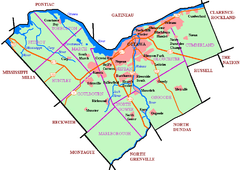
William Lyon Mackenzie King was a Canadian statesman and politician who served as the tenth prime minister of Canada for three non-consecutive terms from 1921 to 1926, 1926 to 1930, and 1935 to 1948. A Liberal, he was the dominant politician in Canada from the early 1920s to the late 1940s. King is best known for his leadership of Canada throughout the Great Depression and the Second World War. He played a major role in laying the foundations of the Canadian welfare state and established Canada's international reputation as a middle power fully committed to world order. With a total of 21 years and 154 days in office, he remains the longest-serving prime minister in Canadian history.

Parliament Hill, colloquially known as The Hill, is an area of Crown land on the southern banks of the Ottawa River in downtown Ottawa, Ontario, Canada. Its Gothic revival suite of buildings, and their architectural elements of national symbolic importance, is the home of the Parliament of Canada. Parliament Hill attracts approximately three million visitors each year. Law enforcement on Parliament Hill and in the parliamentary precinct is the responsibility of the Parliamentary Protective Service (PPS).

24 Sussex Drive, originally called Gorffwysfa and usually referred to simply as 24 Sussex, is the official residence of the prime minister of Canada, located in the New Edinburgh neighbourhood of Ottawa, Ontario. Built between 1866 and 1868 by Joseph Merrill Currier, it has been the official home of the prime minister of Canada since 1951. It is one of two official residences made available to the prime minister, the Harrington Lake estate in nearby Gatineau Park being the other.
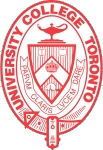
University College, popularly referred to as UC, is a constituent college of the University of Toronto, created in 1853 specifically as an institution of higher learning free of religious affiliation. It was the founding member of the university's modern collegiate system, and its non-denominationalism contrasted with contemporary colleges at the time, such as Trinity College and St. Michael's College, both of which later became part of the University of Toronto.

Sussex Drive, also known as Ottawa Regional Road 93, is an arterial road in Ottawa, Ontario, the capital of Canada. It is one of the city's main ceremonial and institutional routes. Travelling roughly parallel to the Ottawa River, Sussex Drive begins as a continuation of Sir George-Étienne Cartier Parkway at Rideau Gate, at the entrance to Rideau Hall. It travels south to Rideau Street, with the portion south of St. Patrick Street forming the northbound half of a one-way pair with Mackenzie Avenue. Both Mackenzie Avenue and Sussex Drive connect with Colonel By Drive at their southern end, which continues south alongside the Rideau Canal.

William Brodie, often known by his title of Deacon Brodie, was a Scottish cabinet-maker, deacon of a trades guild, and Edinburgh city councillor, who maintained a secret life as a housebreaker, partly for the thrill, and partly to fund his gambling.

Somerset Street is a street in Ottawa, Ontario, Canada. It is divided into Somerset Street East and Somerset Street West by the Rideau Canal.
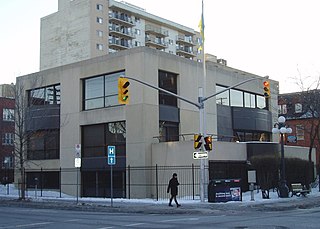
The Embassy of Ukraine, Ottawa is Ukraine's diplomatic mission in Ottawa, Ontario, Canada. Canada was the first western nation to recognize Ukraine's independence on December 2, 1991. The existence of a large Ukrainian-Canadian community has led to continued close relations between the two nations. The Ukrainian embassy was established on May 3, 1992. Originally in rented apartments, then it moved to a heritage building at 331 Metcalfe Street, that was purchased with the aid of donations from Ukrainian-Canadians.
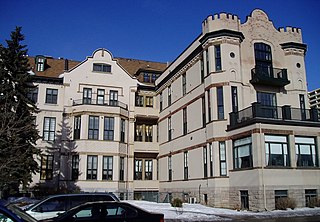
Wallis House is a prominent landmark building in Ottawa, Ontario, Canada. It is located at the corner of Rideau Street and Charlotte Street. Today, after restoration, the building serves as a deluxe condominium complex.

Australia House in Ottawa, Ontario, Canada is the official residence of the Australian High Commissioner to Canada. The house is located on a corner lot at 407 Wilbrod Street in the Sandy Hill neighbourhood of Ottawa, near to a number of other embassies and official residences. The house was built in 1910 by William Davis, and is believed to have been designed by John W.H. Watts. Davis died under inauspicious circumstances in 1916 and it lay vacant for several years before being purchased by Colonel Cameron Macpherson Edwards, who had earlier lived at 24 Sussex Drive. The Edwards left in 1937 and rented the house to Germany to house the Consul General Dr. Erich Windels, who was friendly with Canadian Prime Minister William Lyon Mackenzie King, who lived nearby. Windels was expelled from Canada upon the declaration of war in September 1939.

Stittsville is a suburban community, part of the Canadian capital of Ottawa, Ontario. It is within the former Goulbourn Township. A part of the National Capital Region, Stittsville is immediately to the southwest of Kanata, adjacent to Richmond and about 20 km (12 mi) west of Downtown Ottawa. The urban part of the community corresponds to Stittsville Ward on Ottawa City Council, and has been represented by Glen Gower since 2018. As of 2021, Stittsville ward had a population of 46,430.
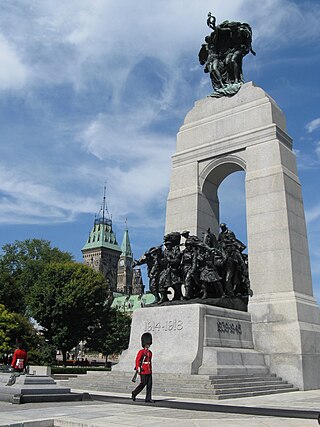
The National War Memorial, titled The Response, is a tall, granite memorial arch with accreted bronze sculptures in Ottawa, Ontario, Canada, designed by Vernon March and first dedicated by King George VI in 1939. Originally built to commemorate the Canadians who died in the First World War, it was in 1982 rededicated to also include those killed in the Second World War and Korean War and again in 2014 to add the dead from the Second Boer War and War in Afghanistan, as well as all Canadians killed in all conflicts past and future. It now serves as the pre-eminent war memorial of 76 cenotaphs in Canada. In 2000, the Tomb of the Unknown Soldier was added in front of the memorial and symbolizes the sacrifices made by all Canadians who have died or may yet die for their country.
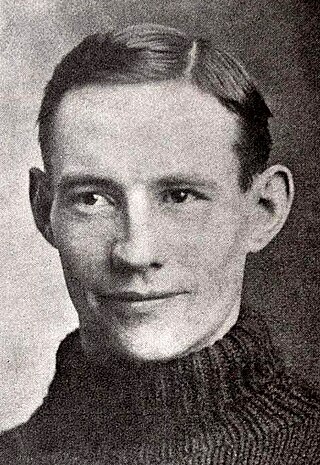
Charles Bruce Stuart was a Canadian amateur and professional ice hockey forward who played for the Quebec Bulldogs, Ottawa Senators, Montreal Wanderers, Portage Lakes Hockey Club, Pittsburgh Victorias and Pittsburgh Professionals from 1899 to 1911. Stuart is considered to be an early version of a power forward, a forward who combines size and physical play with scoring ability, in hockey history. Stuart won the Stanley Cup with both the Ottawa Senators and the Montreal Wanderers.

Orchard Portman is a village and civil parish in Somerset, England, situated 2 miles (3.2 km) south of Taunton in the Somerset West and Taunton district. The village has a population of 150.

Henry Albert Harper was a Canadian journalist and civil servant. He may be best known as a friend of future Prime Minister William Lyon Mackenzie King. Harper is commemorated by a statue on Parliament Hill after his death while trying to save someone from drowning.

Hintonburg is a neighbourhood in Kitchissippi Ward in Ottawa, Ontario, Canada, located west of the Downtown core. It is a historically working-class, predominantly residential neighbourhood, with a commercial strip located along Wellington Street West. It is home to the Parkdale Farmer's Market, located along Parkdale Avenue, just north of Wellington.

Confederation Park(French: Parc de la Confédération) is a public park and National Historic Site of Canada, located in the downtown core of Ottawa, Ontario, Canada. It is bordered on the south by Laurier Avenue and Ottawa City Hall; on the east by the Rideau Canal and National Defence Headquarters; on the north by the Mackenzie King Bridge, the Rideau Centre and the National Arts Centre; and to the west by Elgin Street and the Lord Elgin Hotel.
The General Report on the Plan for the National Capital (1946–1950), or Gréber Plan, was a major urban plan developed for Canada's National Capital Region in 1950 by Jacques Gréber, commissioned by the Federal District Commission of Ottawa, Ontario.
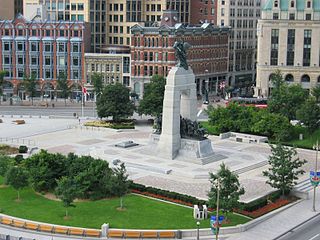
Confederation Square is an urban square in Ottawa, Ontario, Canada, and is considered the second most important ceremonial centre in Canada's capital city, after Parliament Hill. Roughly triangular in area, with Canada's National War Memorial at its centre and the Valiants Memorial at its periphery, the square is bounded by Wellington Street to the north and branches of Elgin Street to the east and west.
Cecil Burgess (1888–1956) was a Canadian architect. He was born in Walkden, Lancashire, England on 8 July 1888. He was educated Walkden, Lancashire, England. He articled to Henry Kirkby, an architect in Manchester, England. Cecil Burgess arrived in Ottawa, Ontario with his parents in 1905. He married Violet Hervey from Round Hill, Nova Scotia, in 1913. The couple had a son, Bernard W. Burgess of Montreal, and a daughter, Mrs. Barbara Joyce Greenwood.

